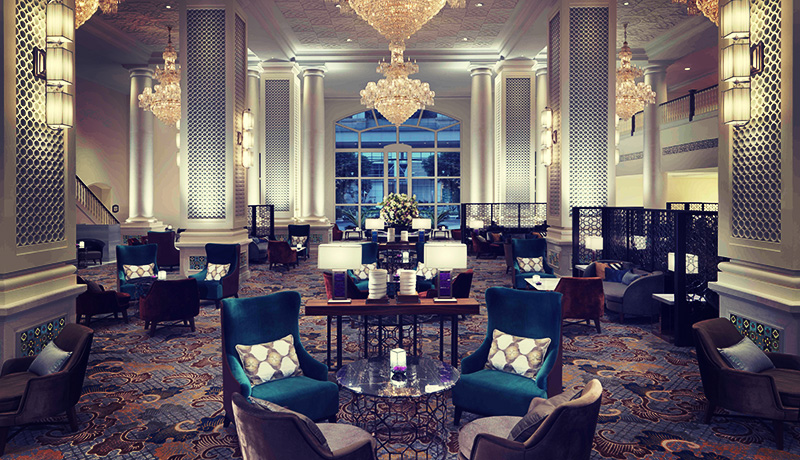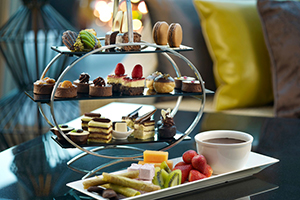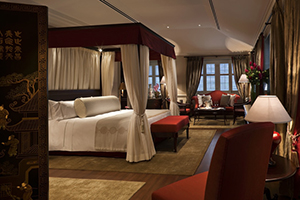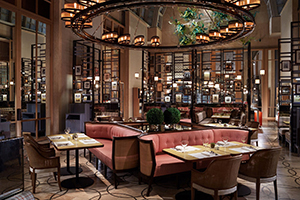
In Singapore, colonialism sells well to tourists.
Colonial-era-built Forbes Travel Guide Four-Star Raffles Singapore, also known as “the Grand Dame of Singapore,” makes more than 500 Singapore Slings a day — a good handful at the Long Bar no less, where the cocktail was invented and a spot favored by novelists Ernest Hemingway and W. Somerset Maugham.
The English custom of afternoon tea, held in two sessions at Five-Star The Fullerton Bay Hotel Singapore’s The Landing Point, is regularly booked up as well.
According to yearly studies done by the Singapore Tourism Board, luxury hotels — colonial properties included — see a healthy occupancy rate of 80 percent and above. And rooms in chic, refurbished shophouse hotels like New Majestic Hotel boast prices around $200 (SGD 275) a night, while Five-Star Capella Singapore’s exclusive black-and-white colonial manors go for $7,890 (SGD 11,000) per night.
The premium prices make sense: Singapore has a short history and only a handful of heritage monuments and sites. For the fast-paced, change-embracing destination, it is increasingly laborious and expensive to preserve these historical sites and buildings.
Singapore’s modern history is one that spans barely two centuries. In 1819, Sir Thomas Stamford Raffles, the founder of British colonial Singapore, set foot on the island. As often credited in Singapore’s history books, this was the beginning of “modern Singapore.” It also marked when its colonial influences began.
In the 50 years following, the population of Singapore grew from 1,000 to 100,000. Traders and immigrants came to this free port from across the region, and from as far as China and Europe. Foundation was laid for shophouses, bungalows and landmarks like Fort Fullerton (1829, where Four-Star The Fullerton Hotel Singapore sits now), Victoria Theatre and Concert Hall (1862) and Raffles Singapore (1887) — iconic addresses that still stand today. While many, like these, have been preserved, many have been demolished as well.
Conservation came late: It was only in the 1970s and 1980s that monument preservation efforts began. By then, buildings like The Grand Hotel de l’Europe (a rival to Raffles hotel), The Adelphi Hotel (Singapore’s oldest hotel, built in 1863) and bungalows like Panglima Prang (Singapore’s oldest-surviving Straits Chinese bungalow) were demolished to give way to new developments.
These conservation efforts are not cheap, nor are they getting cheaper: Raffles cost $114 million (SGD 160 million) to restore in 1989. The Fullerton Hotel Singapore had a $287 million (SGD 400 million) price tag in 2001. The latest landmark to be restored, the National Gallery Singapore (former Supreme Court Building), totaled $385 million (SGD 530 million) by the time it was completed in late 2015.
But this amount of spending is worth it for travel-friendly Singapore. Tourism is a $17 billion (SGD 23 billion) industry in the city-state, with accommodations and sightseeing making up around 40 percent of that revenue.
Heritage and nostalgia are what attract tourists, and if the local hotels can merge their colonial past with the offerings, why not? “It appears that tourists are always seeking authentic, local experiences and cultures in the cities they visit,” said Christian Gurtner, manager of The Ritz-Carlton, Millenia Singapore, a Four-Star hotel.
To add to that, there aren’t many sites that can lay authentic claim to Singapore’s heritage. There are less than 80 gazetted national monuments, of which only the The Fullerton Hotel Singapore’s building, Goodwood Park Hotel’s tower block and Raffles Singapore are a part.
Oxford University visiting fellow and author Ashley Jackson astutely observed in his book, Buildings of Empire: “Raffles Hotel was able to position itself as more than a hotel, becoming a must-see tourist attraction complete with its own private museum, souvenirs and literature propagating its history and myths. It has managed to insinuate itself into Singapore’s very identity and become part of its interface with the world.”
The Grand Dame’s presidential suites illustrate this point. They are furnished in the style of 1920s black-and-white bungalows to “evoke the romance of history,” as explained in the hotel’s press release. The Fullerton Hotel has positioned itself similarly as a heritage luxury hotel, as has Hotel Fort Canning.
“Our guests choose us for the opportunity to stay in a property steeped in rich culture and heritage,” a spokesperson for Hotel Fort Canning said. “Some of our room packages are also bundled with a buggy tour in Fort Canning Park to explore the Colonial history trail, Spice trail, Ancient history trail, Art sculpture trail and the Heritage tree trail.”
It isn’t only the heritage monuments that are making the effort to market Singapore’s past. The Ritz-Carlton, Millenia has recently transformed its lobby-level dining space into Colony. “The restaurant’s concept was inspired by Singapore’s diverse heritage that transformed the nation, giving its cuisine a sense of identity,” Gurtner explained. “Response to Colony has been fantastic. With Colony, we are able to share a part of Singapore’s history and convey an entire dining experience through the colonial-themed interior design, butler-style uniforms and music, which incorporates influences from the British colonial period.”
Another Four-Star hotel, InterContinental Singapore, has also undergone refurbishment, resting on a design that highlights its colonial-style interior columns. As Jackson also said in his book, “Internal innovation is the order of the day, with a touch of historical romanticization thrown in.”
Along those same lines, afternoon tea has become synonymous with service at luxury hotels — all of the properties mentioned here offer the light meal, with some places adding a Singaporean spin to the English custom. For example, at The Landing Point — an area where Singapore’s first immigrants arrived — kueh lapis (Southeast Asian layered cake) is served during the daily afternoon tea. Even the British-style, three-tier set at The Ritz-Carlton Millenia comes with pandan (screwpine) or pineapple-flavored tea syrups.
At Raffles Singapore, afternoon tea is a classic part of the experience. “Raffles Hotel has successfully and fortuitously managed to become part of the ‘heritage’ package, part of Singapore’s identity, the colonial part manifest in the present and the national story going into the future,” Jackson said.
Looking at how successfully Singapore has embraced and presented her heritage to the yearly influx of 15 million tourists, experiencing this package is indeed the dream for many.




